Page 57 of 450
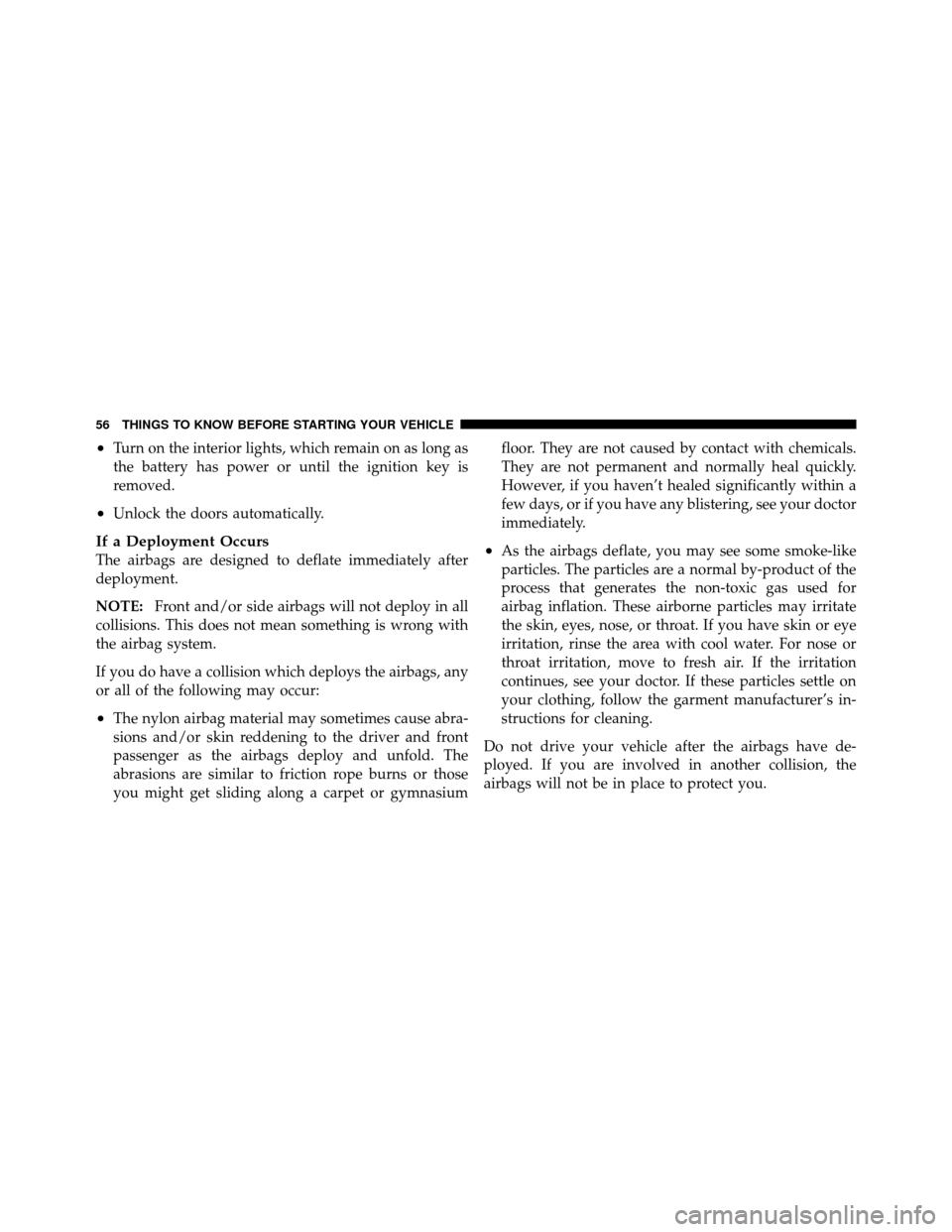
•Turn on the interior lights, which remain on as long as
the battery has power or until the ignition key is
removed.
•Unlock the doors automatically.
If a Deployment Occurs
The airbags are designed to deflate immediately after
deployment.
NOTE:Front and/or side airbags will not deploy in all
collisions. This does not mean something is wrong with
the airbag system.
If you do have a collision which deploys the airbags, any
or all of the following may occur:
•The nylon airbag material may sometimes cause abra-
sions and/or skin reddening to the driver and front
passenger as the airbags deploy and unfold. The
abrasions are similar to friction rope burns or those
you might get sliding along a carpet or gymnasium floor. They are not caused by contact with chemicals.
They are not permanent and normally heal quickly.
However, if you haven’t healed significantly within a
few days, or if you have any blistering, see your doctor
immediately.
•As the airbags deflate, you may see some smoke-like
particles. The particles are a normal by-product of the
process that generates the non-toxic gas used for
airbag inflation. These airborne particles may irritate
the skin, eyes, nose, or throat. If you have skin or eye
irritation, rinse the area with cool water. For nose or
throat irritation, move to fresh air. If the irritation
continues, see your doctor. If these particles settle on
your clothing, follow the garment manufacturer’s in-
structions for cleaning.
Do not drive your vehicle after the airbags have de-
ployed. If you are involved in another collision, the
airbags will not be in place to protect you.
56 THINGS TO KNOW BEFORE STARTING YOUR VEHICLE
Page 59 of 450
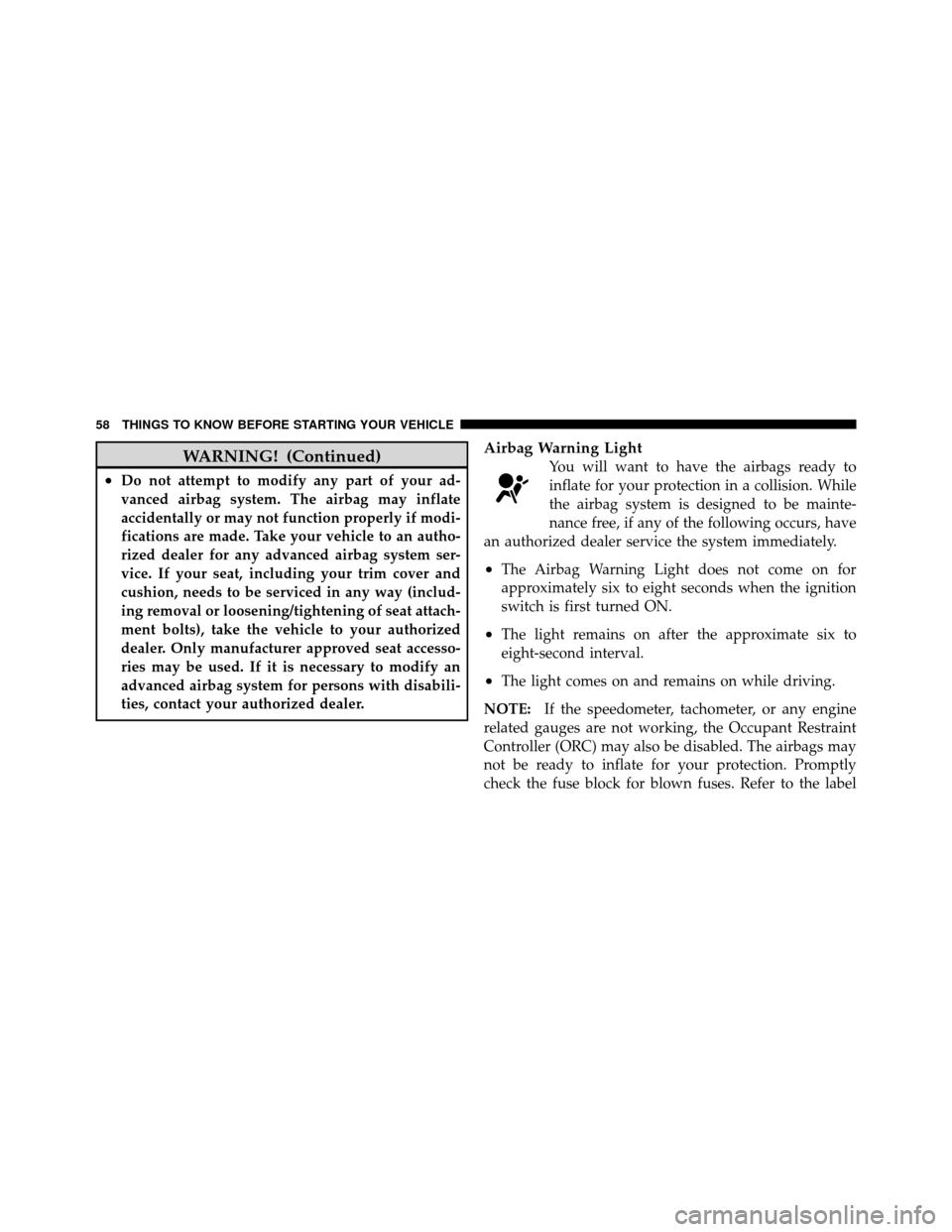
WARNING! (Continued)
•Do not attempt to modify any part of your ad-
vanced airbag system. The airbag may inflate
accidentally or may not function properly if modi-
fications are made. Take your vehicle to an autho-
rized dealer for any advanced airbag system ser-
vice. If your seat, including your trim cover and
cushion, needs to be serviced in any way (includ-
ing removal or loosening/tightening of seat attach-
ment bolts), take the vehicle to your authorized
dealer. Only manufacturer approved seat accesso-
ries may be used. If it is necessary to modify an
advanced airbag system for persons with disabili-
ties, contact your authorized dealer.
Airbag Warning Light
You will want to have the airbags ready to
inflate for your protection in a collision. While
the airbag system is designed to be mainte-
nance free, if any of the following occurs, have
an authorized dealer service the system immediately.
•The Airbag Warning Light does not come on for
approximately six to eight seconds when the ignition
switch is first turned ON.
•The light remains on after the approximate six to
eight-second interval.
•The light comes on and remains on while driving.
NOTE: If the speedometer, tachometer, or any engine
related gauges are not working, the Occupant Restraint
Controller (ORC) may also be disabled. The airbags may
not be ready to inflate for your protection. Promptly
check the fuse block for blown fuses. Refer to the label
58 THINGS TO KNOW BEFORE STARTING YOUR VEHICLE
Page 61 of 450
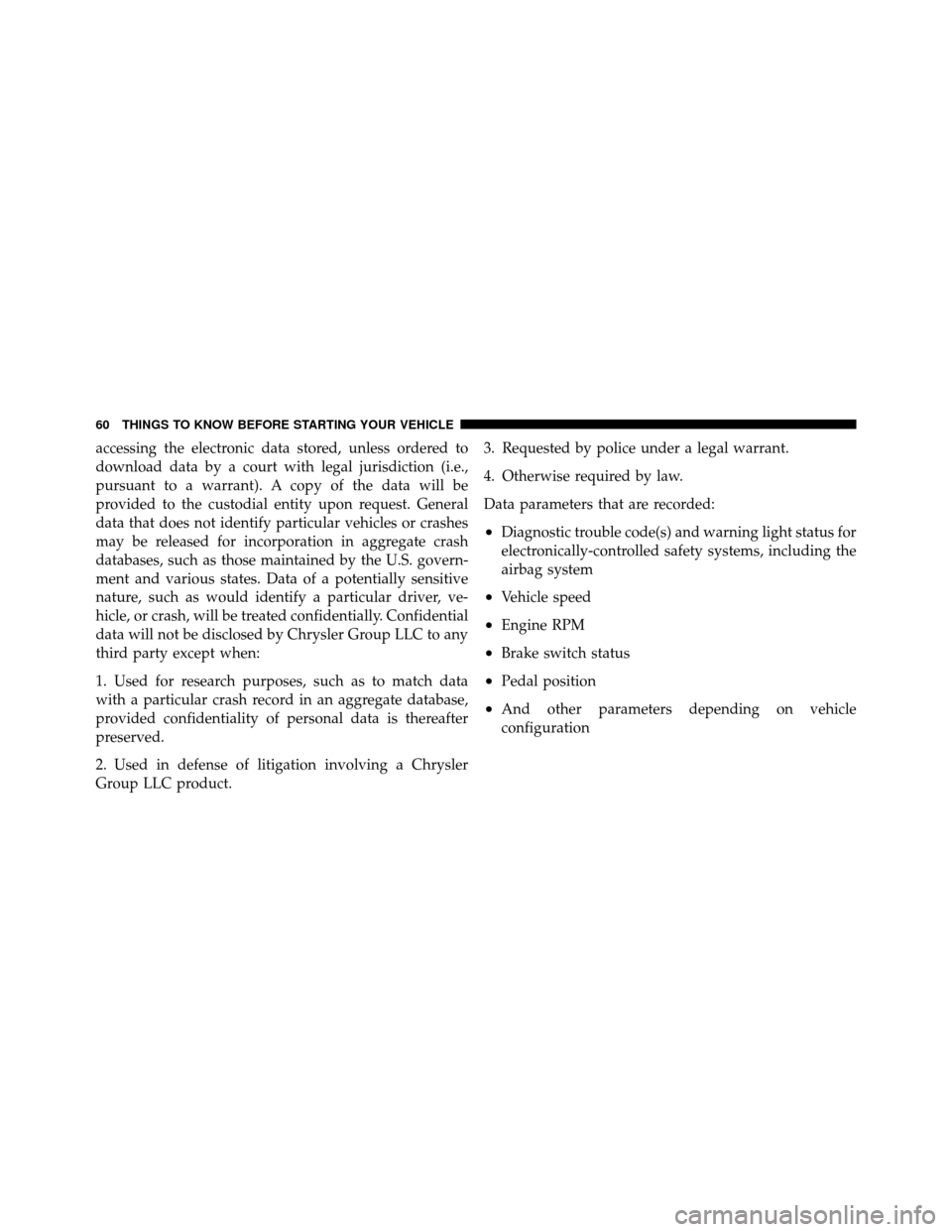
accessing the electronic data stored, unless ordered to
download data by a court with legal jurisdiction (i.e.,
pursuant to a warrant). A copy of the data will be
provided to the custodial entity upon request. General
data that does not identify particular vehicles or crashes
may be released for incorporation in aggregate crash
databases, such as those maintained by the U.S. govern-
ment and various states. Data of a potentially sensitive
nature, such as would identify a particular driver, ve-
hicle, or crash, will be treated confidentially. Confidential
data will not be disclosed by Chrysler Group LLC to any
third party except when:
1. Used for research purposes, such as to match data
with a particular crash record in an aggregate database,
provided confidentiality of personal data is thereafter
preserved.
2. Used in defense of litigation involving a Chrysler
Group LLC product.3. Requested by police under a legal warrant.
4. Otherwise required by law.
Data parameters that are recorded:
•Diagnostic trouble code(s) and warning light status for
electronically-controlled safety systems, including the
airbag system
•Vehicle speed
•Engine RPM
•Brake switch status
•Pedal position
•And other parameters depending on vehicle
configuration
60 THINGS TO KNOW BEFORE STARTING YOUR VEHICLE
Page 77 of 450
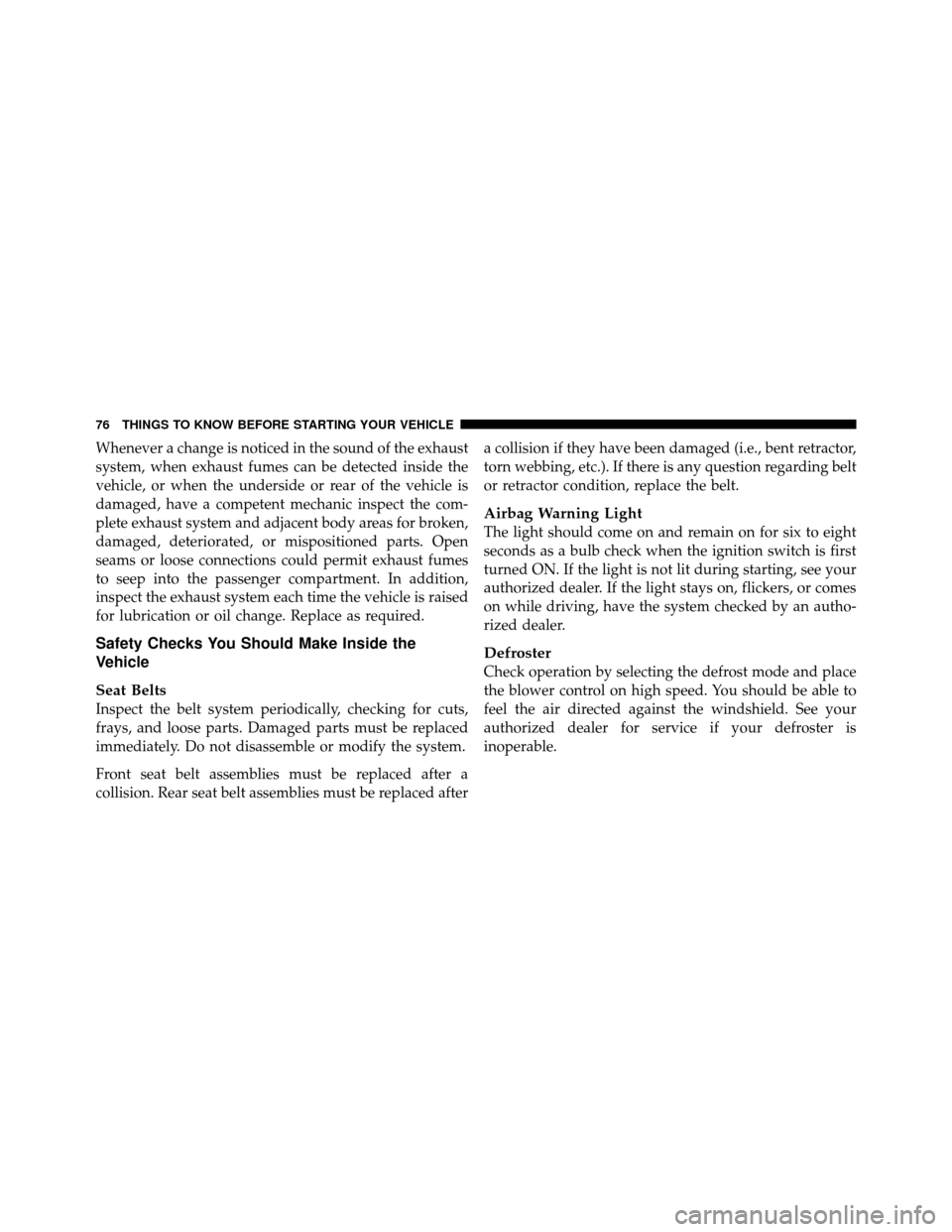
Whenever a change is noticed in the sound of the exhaust
system, when exhaust fumes can be detected inside the
vehicle, or when the underside or rear of the vehicle is
damaged, have a competent mechanic inspect the com-
plete exhaust system and adjacent body areas for broken,
damaged, deteriorated, or mispositioned parts. Open
seams or loose connections could permit exhaust fumes
to seep into the passenger compartment. In addition,
inspect the exhaust system each time the vehicle is raised
for lubrication or oil change. Replace as required.
Safety Checks You Should Make Inside the
Vehicle
Seat Belts
Inspect the belt system periodically, checking for cuts,
frays, and loose parts. Damaged parts must be replaced
immediately. Do not disassemble or modify the system.
Front seat belt assemblies must be replaced after a
collision. Rear seat belt assemblies must be replaced aftera collision if they have been damaged (i.e., bent retractor,
torn webbing, etc.). If there is any question regarding belt
or retractor condition, replace the belt.
Airbag Warning Light
The light should come on and remain on for six to eight
seconds as a bulb check when the ignition switch is first
turned ON. If the light is not lit during starting, see your
authorized dealer. If the light stays on, flickers, or comes
on while driving, have the system checked by an autho-
rized dealer.
Defroster
Check operation by selecting the defrost mode and place
the blower control on high speed. You should be able to
feel the air directed against the windshield. See your
authorized dealer for service if your defroster is
inoperable.
76 THINGS TO KNOW BEFORE STARTING YOUR VEHICLE
Page 78 of 450
Periodic Safety Checks You Should Make Outside
the Vehicle
Tires
Examine tires for excessive tread wear and uneven wear
patterns. Check for stones, nails, glass, or other objects
lodged in the tread. Inspect the tread and sidewall for
cuts and cracks. Check the wheel nuts for tightness.
Check the tires (including spare) for proper pressure.
Lights
Have someone observe the operation of exterior lights
while you work the controls. Check turn signal and high
beam indicator lights on the instrument panel.
Door Latches
Check for positive closing, latching, and locking.
Fluid Leaks
Check area under vehicle after overnight parking for fuel,
engine coolant, oil, or other fluid leaks. Also, if gasoline
fumes are detected or if fuel, power steering fluid, or
brake fluid leaks are suspected, the cause should be
located and corrected immediately.2
THINGS TO KNOW BEFORE STARTING YOUR VEHICLE 77
Page 81 of 450
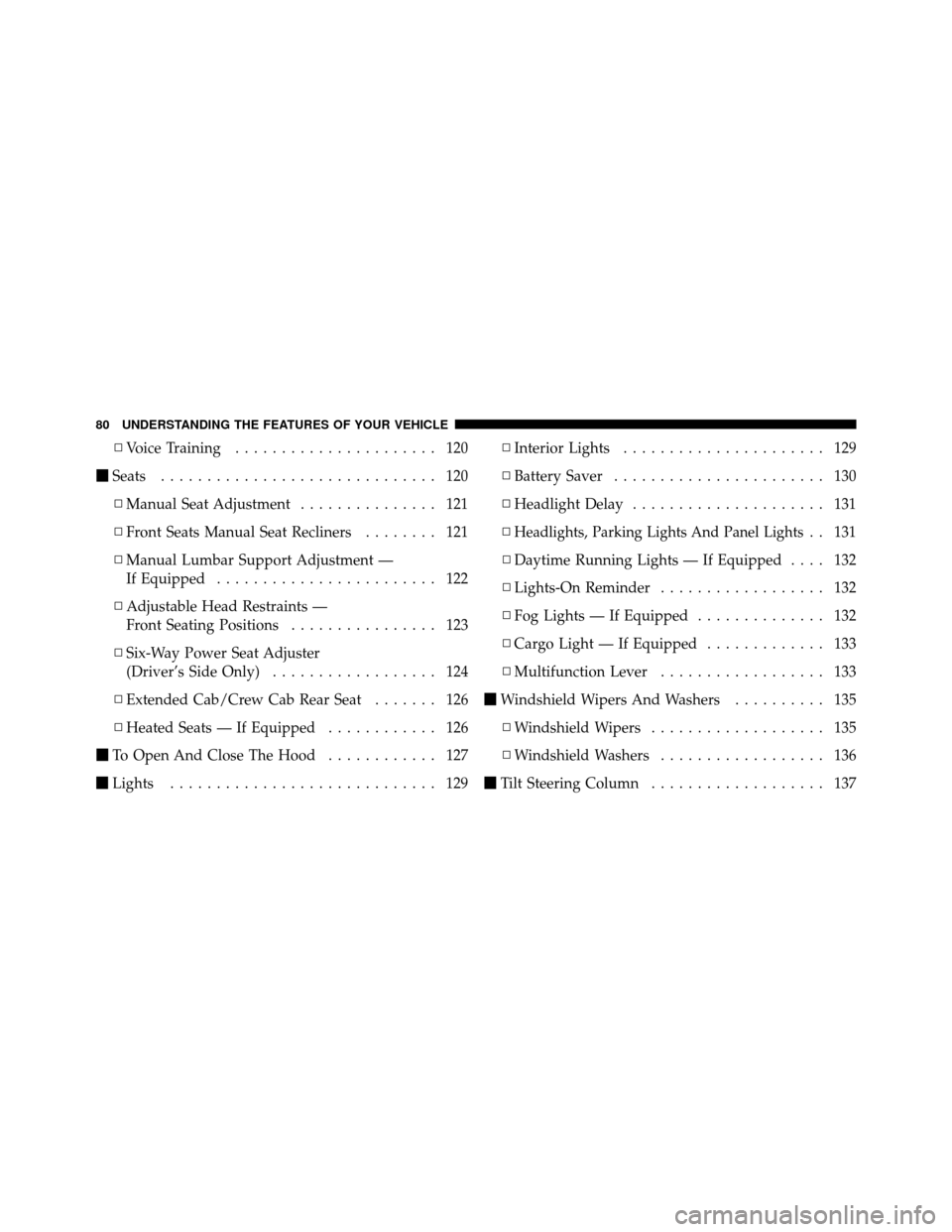
▫Voice Training ...................... 120
� Seats .............................. 120
▫ Manual Seat Adjustment ............... 121
▫ Front Seats Manual Seat Recliners ........ 121
▫ Manual Lumbar Support Adjustment —
If Equipped ........................ 122
▫ Adjustable Head Restraints —
Front Seating Positions ................ 123
▫ Six-Way Power Seat Adjuster
(Driver’s Side Only) .................. 124
▫ Extended Cab/Crew Cab Rear Seat ....... 126
▫ Heated Seats — If Equipped ............ 126
� To Open And Close The Hood ............ 127
� Lights ............................. 129 ▫
Interior Lights ...................... 129
▫ Battery Saver ....................... 130
▫ Headlight Delay ..................... 131
▫
Headlights, Parking Lights And Panel Lights. . 131
▫ Daytime Running Lights — If Equipped .... 132
▫ Lights-On Reminder .................. 132
▫ Fog Lights — If Equipped .............. 132
▫ Cargo Light — If Equipped ............. 133
▫ Multifunction Lever .................. 133
� Windshield Wipers And Washers .......... 135
▫ Windshield Wipers ................... 135
▫ Windshield Washers .................. 136
� Tilt Steering Column ................... 137
80 UNDERSTANDING THE FEATURES OF YOUR VEHICLE
Page 82 of 450
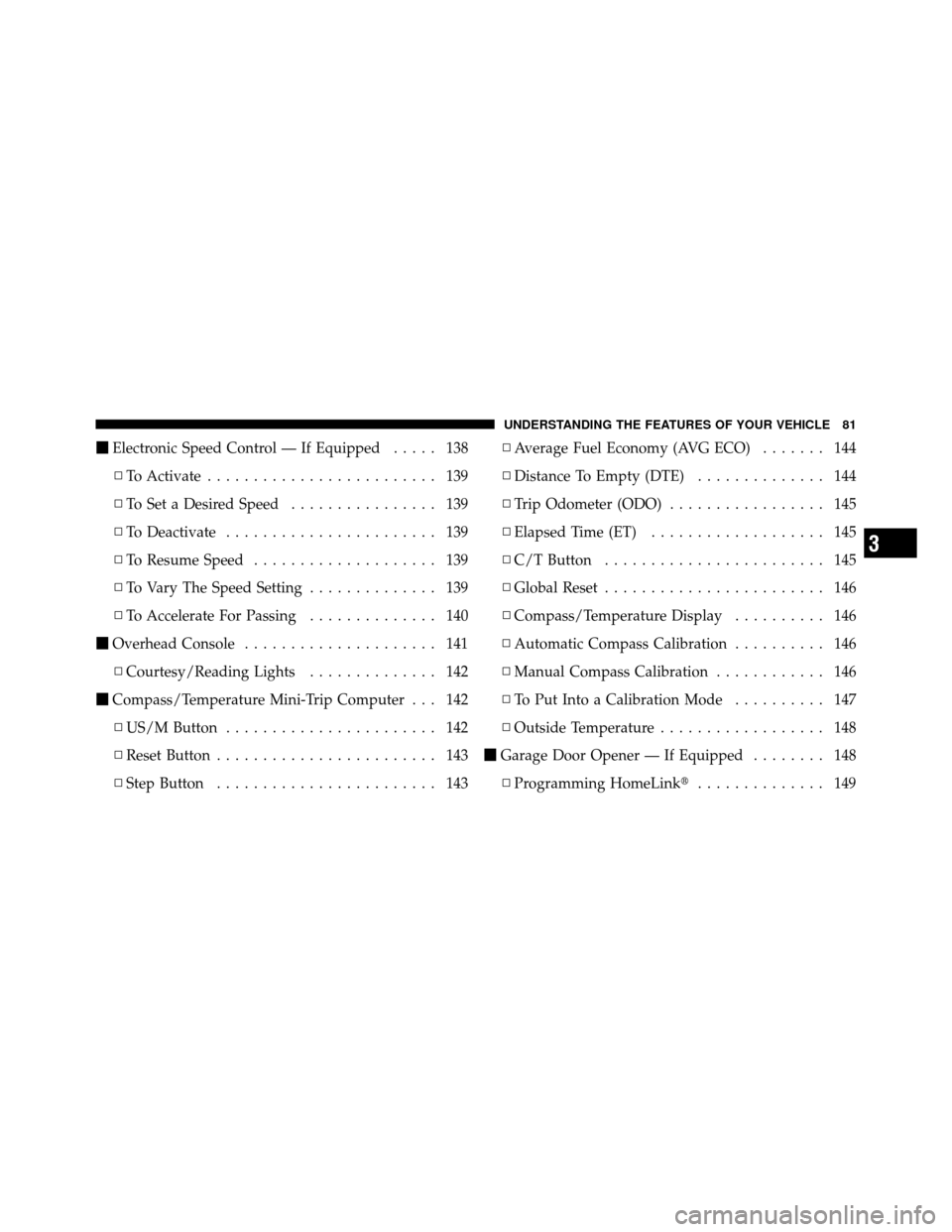
�Electronic Speed Control — If Equipped ..... 138
▫ To Activate ......................... 139
▫ To Set a Desired Speed ................ 139
▫ To Deactivate ....................... 139
▫ To Resume Speed .................... 139
▫ To Vary The Speed Setting .............. 139
▫ To Accelerate For Passing .............. 140
� Overhead Console ..................... 141
▫ Courtesy/Reading Lights .............. 142
� Compass/Temperature Mini-Trip Computer . . . 142
▫ US/M Button ....................... 142
▫ Reset Button ........................ 143
▫ Step Button ........................ 143 ▫
Average Fuel Economy (AVG ECO) ....... 144
▫ Distance To Empty (DTE) .............. 144
▫ Trip Odometer (ODO) ................. 145
▫ Elapsed Time (ET) ................... 145
▫ C/T Button ........................ 145
▫ Global Reset ........................ 146
▫ Compass/Temperature Display .......... 146
▫ Automatic Compass Calibration .......... 146
▫ Manual Compass Calibration ............ 146
▫ To Put Into a Calibration Mode .......... 147
▫ Outside Temperature .................. 148
� Garage Door Opener — If Equipped ........ 148
▫ Programming HomeLink� .............. 149
3
UNDERSTANDING THE FEATURES OF YOUR VEHICLE 81
Page 84 of 450
MIRRORS
Inside Day/Night Mirror
A two-point pivot system allows for horizontal and
vertical adjustment of the mirror. The mirror should be
adjusted to center on the view through the rear window.
Headlight glare can be reduced by moving the small
control under the mirror to the night position (toward the
rear of the vehicle). The mirror should be adjusted while
set in the day position (toward the windshield).
Adjusting Rearview Mirror
3
UNDERSTANDING THE FEATURES OF YOUR VEHICLE 83